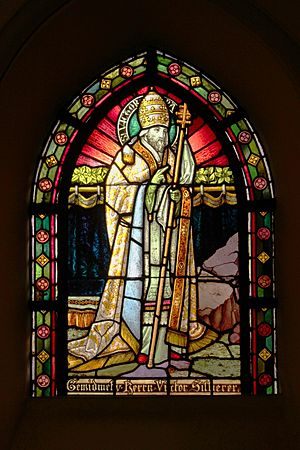Pope Victor I facts for kids
Quick facts for kids Pope Saint Victor I |
|
|---|---|
| Bishop of Rome | |

Stained glass image of Pope-Saint Victor, with anachronistic papal tiara (Semmering, Austria)
|
|
| Church | Catholic Church |
| Papacy began | 189 |
| Papacy ended | 199 |
| Predecessor | Eleutherius |
| Successor | Zephyrinus |
| Personal details | |
| Born | Early 2nd Century AD Africa Proconsulare, Roman Empire |
| Died | 199 AD Rome, Roman Empire |
| Sainthood | |
| Feast day | 28 July or 11 January |
| Other Popes named Victor | |
Pope Victor I was the Bishop of Rome (the leader of the Catholic Church) from about 189 to 199 AD. He was born in the Roman province of Africa, which is now part of modern-day Libya or Tunisia. He is remembered as a saint, and his special day (feast day) is celebrated on July 28.
Contents
Pope Victor I: His Life and Role
Pope Victor I served as the leader of the Christian church in Rome during the late 2nd century. He was an important figure who helped shape some of the early practices of Christianity.
When Did Pope Victor I Serve?
Historians believe Pope Victor I was the Bishop of Rome for about nine or ten years. His time as pope was likely from 189 AD to 199 AD. During this period, the Christian church was still growing and figuring out many of its traditions.
Key Decisions and Challenges
Pope Victor I is best known for his strong stand on when to celebrate Easter. This was a big debate in the early church.
The Easter Debate: A Major Challenge
Before Victor I, different Christian communities celebrated Easter on different days.
- Some churches, especially in Asia Minor (modern-day Turkey), celebrated Easter on the 14th day of the Jewish month of Nisan. This was the day before the Jewish Passover, no matter what day of the week it fell on. They were called Quartodecimans.
- Other churches, including the one in Rome, believed Easter should always be celebrated on a Sunday. This was because Jesus's resurrection happened on a Sunday.
Many church leaders held meetings to discuss this. Most agreed that Easter should be on a Sunday. However, they also felt that having different traditions was okay and not a reason to break ties.
Victor's Strong Stance
Pope Victor I disagreed. He believed all Christians should celebrate Easter on the same day. He decided to break ties with the churches in Asia Minor that continued to celebrate on the 14th of Nisan. This was a very strong action.
Advice from Other Leaders
Other important church leaders, like Irenaeus from Gaul (modern-day France), told Victor to be more understanding. They thought it was better to be tolerant of different traditions. Despite this, Victor I's actions showed how important it was to him for the church to have unified practices.
Other Important Actions
Victor I also took action against a teacher named Theodotus of Byzantium. Theodotus taught that Jesus was only a man and not divine. Victor I removed him from the church for teaching something different from what Christians believed about Jesus.
See also
 In Spanish: Víctor I para niños
In Spanish: Víctor I para niños
- List of Catholic saints
- List of popes
Images for kids
-
Stained glass image of Pope-Saint Victor, with anachronistic papal tiara (Semmering, Austria)


